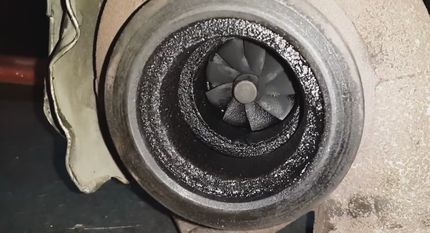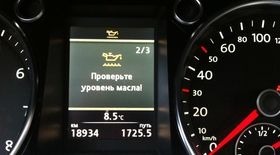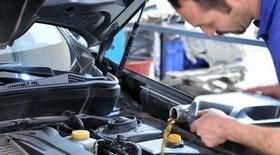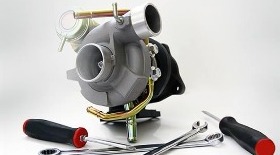
Turbine oil leaking
Turbine oil can fly out for a variety of reasons, namely, due to a clogged air filter or air intake system, the oil began to burn or it did not initially correspond to the temperature regime, coking of the ICE oil channels. More complex causes are impeller failure, significant wear of the turbine bearings, jamming of its shaft, due to which the impeller does not rotate at all. However, in most cases, oil leakage from the turbine is due to simple repair faults, most of which many car owners are quite capable of fixing on their own.
Causes of oil consumption in the turbine
Before proceeding to the consideration of exactly the reasons due to which oil leakage is possible, it is necessary to determine its allowable volume. The fact is that any, even fully serviceable, turbine will eat up oil. And this consumption will be the greater, the more the internal combustion engine itself and the turbine will work at high speeds. Without going into the details of this process, it should be noted that the approximate normal oil consumption of a turbocharged engine is about 1,5 ... 2,5 liters per 10 thousand kilometers. But if the value of a similar flow rate has exceeded 3 liters, then this is already a reason to think about finding a breakdown.

High oil consumption
If the internal combustion engine is consuming oil, then this at least indicates a breakdown of the CPG, wear of the oil caps or clogged crankcase ventilation. High oil consumption - signs, causes and what needs to be done Read more
Let's start with the simplest reasons why a situation may arise when oil is driven from the turbine. usually, the situation is due to the fact that the locking rings, which, in fact, prevent the oil from flowing out of the turbine, wear out and begin to leak. This happens due to the fact that the pressure in the unit drops, and in turn, oil drips from the turbine to where there is less pressure, that is, to the outside. So, let's move on to the reasons.
Clogged air filter. This is the simplest situation, which, however, can cause the indicated problem. You need to check the filter and replace it if necessary (in rare cases, it turns out to clean it, but it’s still better not to tempt fate and put in a new one, especially if you operate the car off-road). In winter, instead of or together with clogging, in some cases it may freeze (for example, in conditions of very high humidity). Whatever it was, be sure to check the condition of the filter.
Air filter box and/or intake pipe. Here the situation is similar. Even if the air filter is in order, you need to check the condition of these components. If they are clogged, you need to correct the situation and clean them. The resistance of the incoming air must be no higher than 20 mm of water column when the internal combustion engine is idling (approximately 2 technical atmospheres, or about 200 kPa). Otherwise, you need to revise and clean the system or its individual elements.
Violation of tightness of a cover of the air filter. If this situation occurs, then dust, sand and small debris will inevitably enter the air system. All these particles will work as an abrasive in the turbine, gradually "kill" it out of order until it is completely out of order. Therefore, in no case should depressurization of the air system of an internal combustion engine with a turbine be allowed.
Poor quality or unsuitable oil. Any internal combustion engine is very sensitive to the quality of engine oil, and turbocharged engines are even more so, since their rotation speeds and temperatures are much higher. Accordingly, firstly, you need to use the oil recommended by the manufacturer of your car. And secondly, you need to make a choice of the lubricant that is of the highest quality, from a more well-known brand, synthetic or semi-synthetic, and not fill any surrogate into the power unit.
Heat resistance of oil. Turbine oil is usually more heat resistant than regular oil, so a suitable lubricating fluid must be used. Such oil does not burn, does not stick to the walls of the turbine elements, does not clog the oil channels and lubricates the bearings normally. Otherwise, the turbine will operate under extreme conditions and there is a risk of its rapid failure.
Oil change interval. In each internal combustion engine, the oil must be changed according to the regulations! For turbocharged internal combustion engines, this is especially true. It is better to carry out the corresponding replacement approximately 10% earlier than specified by the vehicle manufacturer's regulations. This will certainly increase the resource of both the internal combustion engine and the turbine.

After how many km to change the oil in the internal combustion engine
The engine oil change interval should be considered based on operating conditions, vehicle mileage, quality of consumables and also 7 factors. Frequency 8-12 thousand km. overall indicator Read more
Condition of the oil inlets. If you do not change the oil for a long time or use low-quality lubricating fluid (or the oil filter will simply be clogged), then there is a risk that over time the oil pipes will become clogged and the turbine will operate in critical mode, which significantly reduces its resource.
Oil leak from turbo to intercooler (intake manifold). This situation appears infrequently, but its cause may be the clogged air filter already mentioned above, its cover or nozzles. Another reason in this case may be clogged oil channels. As a result of this, a pressure difference occurs, due to which, in fact, the oil “spits out” into the intercooler.
Oil getting into muffler. Here it is similar to the previous point. A pressure difference appears in the system, which is provoked either by a clogged air system (air filter, pipe, cover) or oil channels. Accordingly, first of all, it is necessary to check the condition of the described systems. If this does not help, it is possible that the turbine itself already has significant wear and you need to revise it, but before that you need to check the turbine.
In some cases, this problem may be due to the use of sealants during the installation of the supply and drain oil pipelines. Their residues could dissolve in the oil and cause the oil channels to coke, including the compressor bearings. In this case, it is necessary to clean the corresponding channels and individual parts of the turbine.
Now we turn to more complex reasons, respectively, and costly repairs. They appear if the turbine is very worn out due to its incorrect operation or simply because of its "old age". Wear could be caused by excessive load on the internal combustion engine, the use of unsuitable or low-quality oil, its replacement not according to the regulations, mechanical damage, and so on.
Failure of the impeller. This situation is possible if there was a significant play on its shaft. This is possible either from old age or from exposure to abrasive materials on the shaft. Whatever the case, the impeller cannot be repaired, it only needs to be changed. In this case, associated repairs are usually carried out. It is hardly worth doing them yourself, it is better to seek help from a car service.
Bearing wear. This results in significant oil consumption. And it can fall into the cavity, in close proximity to them. And since the bearings are not repairable, they need to be changed. It is also better to seek help from a car service. In some cases, the problem is not so much in the nominal replacement of bearings, but in their selection (for example, for rare cars, you need to order spare parts from abroad and wait a considerable time until they are delivered).
Jamming of the impeller shaft. At the same time, it does not rotate at all, that is, the turbine does not work. This is one of the most difficult situations. Usually it jams due to skew. In turn, misalignment can occur due to mechanical damage, significant wear or failure of the bearings. Here you need a comprehensive diagnosis and repair, so you need to seek help from a car service.

turbine failure. How to troubleshoot?
Useful recommendations for troubleshooting a breakdown of a car's internal combustion engine turbine. 3 common causes of turbine failure and the main signs of turbocharger failure. And also how to eliminate them Read more
Breakdown elimination methods
Naturally, the choice of one or another troubleshooting solution directly depends on what exactly caused the oil to drip or flow from the turbine. However, we list the most likely options, from simple to more complex.
- Replacement (in extreme, not undesirable case, cleaning) of the air filter. Remember that it is desirable to change the filter a little earlier than the regulations, by about 10%. On average, it must be replaced at least every 8-10 thousand kilometers.
- Checking the condition of the air filter cover and nozzles, if a blockage is found, be sure to thoroughly clean them by removing debris.
- Check the tightness of the air filter cover and pipes. If cracks or other damage are found, depending on the situation, you can try to repair them by applying clamps or other devices, in extreme cases, you need to buy new parts to replace the damaged ones. In this case, a prerequisite is that if a depressurization has been detected, then before assembling the system with new components, it must be thoroughly cleaned from the debris and dust that are in it. If this is not done, the debris will play the role of an abrasive and significantly wear out the turbine.
- correct selection of engine oil and its timely replacement. This is true for all internal combustion engines, and especially for those equipped with a turbocharger. It is better to use high-quality synthetic or semi-synthetic oils from well-known manufacturers such as Shell, Mobil, Liqui Moly, Castrol and others.
- Periodically, it is necessary to monitor the condition of the oil pipes so that they ensure the normal pumping of oil through the oil system, namely, to and from the turbine. In the event that you completely change the turbine, then for preventive purposes you need to clean them, even if at first glance they are relatively clean. It won't be redundant!
- It is necessary to regularly check the condition of the shaft, impeller and bearings, to prevent their significant play. At the slightest suspicion of a breakdown, a diagnosis should be made. It is better to do this in a car service, where the appropriate equipment and tools are located.
- If there is oil at the outlet of the turbine, then it is worth checking the condition of the drain tube, the presence of critical bends in it. In this case, the oil level in the crankcase must be higher than at the hole of that tube. It is also worth checking the ventilation of the crankcase gases. Please note that the condensate that forms in the exhaust manifold due to temperature differences is often mistaken for oil, since moisture, mixing with dirt, turns black. You need to be careful and make sure that it is really oil.
- If there is a leak in the intake or exhaust system of the internal combustion engine, then it is also worth checking the condition of the gaskets. Over time and under the influence of high temperatures, it can significantly wear out and fail. Accordingly, it must be replaced with a new one. you need to do it yourself only if you are confident in your knowledge and practical experience in performing such work. In some cases, instead of replacing, a simple tightening of the tightening bolts helps (but less often). However, it is also impossible to overtighten too much, since this can lead to the opposite consequences, when the gasket will not hold pressure at all.
you also need to remember that operation at high loads (at high speeds) contributes not only to excessive wear of the turbocharger, but can also lead to deformation of the rotor shaft bearing, oil burning, and a general decrease in the resource of its individual parts. Therefore, if possible, this mode of operation of the internal combustion engine should be avoided.
Rare cases
Now let's dwell on more rare, private cases, which, however, sometimes worry motorists.
Mechanical damage to the turbine. namely, it may be due to an accident or other accident, hitting the impeller with some foreign heavy object (for example, a bolt or nut left after installation), or simply a defective product. In this case, unfortunately, the repair of the turbine is hardly possible, and it is better to change it, since the damaged unit will still have a much lower resource, so it will be unprofitable from an economic point of view.
For example, there is oil leak outside the turbine on the compressor side. If at the same time the diffuser disk is attached to the core with bolts, for example, as it is implemented in the Holset H1C or H1E turbochargers, then one of the four mounting bolts may have reduced the tension or broken. It is less likely to be lost due to vibration. However, if it simply does not exist, you need to install a new one and tighten all the bolts with the necessary torque. But when the bolt broke and its inner part got into the turbine, then it must be dismantled and an attempt should be made to find the broken part. Worst case scenario is to replace it completely.
Leak from the connection of the diffuser disk with the volute. Here the problem is that you need to make sure that the oil follows from the said compound. Since in older models of turbochargers a special grease was used to ensure their tightness. However, during operation of the turbine, under the influence of high temperatures and damage to the seals, this lubricant can leak. Therefore, for additional diagnostics, it is necessary to dismantle the snail and find out if there are oil leaks inside the air valves. If they are not there, and instead of them there is only moisture, then you can not worry, wipe it with a rag, and assemble the entire unit to its original state. Otherwise, you need to make additional diagnostics and use one of the above tips.
High oil level in crankcase. Occasionally, in turbocharged ICEs, excess oil can pour out of the system due to its high level in the crankcase (above the MAX mark). In this case, it is necessary to drain the excess lubricant to the maximum allowable level. this can be done either in a garage or in a car service.
Design features of internal combustion engines. namely, cases are known when some motors, by virtue of their design, themselves created resistance to gravity draining of oil from the compressor. namely, this happens because the counterweight of the crankshaft of the internal combustion engine with its mass, as it were, throws the oil back. And now nothing can be done. You just need to carefully monitor the cleanliness of the motor and the oil level.
Wear of elements of the cylinder-piston group (CPG). In this case, a situation is possible when the exhaust gases break into the oil pan and create increased pressure there. This is especially aggravated if the ventilation of the crankcase gases does not work correctly or not fully. Accordingly, at the same time, gravity draining of the oil is difficult, and the turbine simply drives it out of the system through weak seals. Especially if the latter are already old and leaky.
Clogged breather filter. It is located in the crankcase ventilation system and can also become clogged over time. And this, in turn, leads to its incorrect operation. Therefore, along with checking the ventilation performance, it is also necessary to check the condition of the indicated filter. If necessary, it must be replaced.
Incorrect installation of the turbine. Or another option is to install a deliberately low-quality or faulty turbine. This option, of course, is rare, but if you performed repairs in a car service with a dubious reputation, then it cannot be ruled out either.
Disabling the EGR valve (EGR). Some drivers, in a situation where the turbine “eats up” oil, are advised to turn off the EGR valve, that is, the exhaust gas recirculation valve. In fact, indeed, such a step can be taken, but the consequences of this event need to be additionally familiarized, since it affects many processes in the internal combustion engine. But remember that even if you decide to take such a step, you still need to find the reason why the oil is “eating up”. Indeed, at the same time, its level is constantly falling, and the operation of the internal combustion engine under conditions of oil starvation is very harmful to the power unit and turbine.
